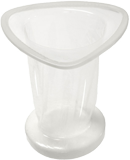Female condom
(Redirected from Female condoms)
Female Condom[edit | edit source]
The female condom is a barrier device used during sexual intercourse as a contraceptive and to reduce the risk of sexually transmitted infections (STIs). It is designed to be worn internally by the female partner and provides a physical barrier that prevents sperm from entering the uterus.
Design and Structure[edit | edit source]
The female condom is typically made from a soft, thin material such as nitrile, latex, or polyurethane. It is a loose-fitting sheath with a flexible ring at each end. The closed end of the condom is inserted into the vagina, while the open end remains outside, covering the external genitalia. This design helps to protect both partners from STIs and provides contraception by blocking sperm from reaching the egg.
Usage[edit | edit source]
To use a female condom, the woman inserts the closed end of the condom into her vagina, ensuring that the inner ring is placed as far back as possible. The outer ring should remain outside the vagina, covering the labia. It is important to ensure that the condom is not twisted and that it is properly positioned before intercourse begins.
Advantages[edit | edit source]
The female condom offers several advantages:
- It provides women with more control over their own sexual health.
- It can be inserted hours before intercourse, allowing for spontaneity.
- It is made from materials that are safe for people with latex allergies.
- It covers a larger area than male condoms, offering more protection against STIs.
Disadvantages[edit | edit source]
Despite its benefits, the female condom also has some disadvantages:
- It may be more expensive than male condoms.
- Some users find it difficult to insert or uncomfortable to use.
- It may produce noise during intercourse, which some find distracting.
Effectiveness[edit | edit source]
When used correctly, the female condom is about 95% effective at preventing pregnancy. However, typical use, which accounts for human error, results in an effectiveness rate of about 79%. It is important to follow the instructions carefully to maximize its effectiveness.
Related Pages[edit | edit source]
Search WikiMD
Ad.Tired of being Overweight? Try W8MD's physician weight loss program.
Semaglutide (Ozempic / Wegovy and Tirzepatide (Mounjaro / Zepbound) available.
Advertise on WikiMD
|
WikiMD's Wellness Encyclopedia |
| Let Food Be Thy Medicine Medicine Thy Food - Hippocrates |
Translate this page: - East Asian
中文,
日本,
한국어,
South Asian
हिन्दी,
தமிழ்,
తెలుగు,
Urdu,
ಕನ್ನಡ,
Southeast Asian
Indonesian,
Vietnamese,
Thai,
မြန်မာဘာသာ,
বাংলা
European
español,
Deutsch,
français,
Greek,
português do Brasil,
polski,
română,
русский,
Nederlands,
norsk,
svenska,
suomi,
Italian
Middle Eastern & African
عربى,
Turkish,
Persian,
Hebrew,
Afrikaans,
isiZulu,
Kiswahili,
Other
Bulgarian,
Hungarian,
Czech,
Swedish,
മലയാളം,
मराठी,
ਪੰਜਾਬੀ,
ગુજરાતી,
Portuguese,
Ukrainian
Medical Disclaimer: WikiMD is not a substitute for professional medical advice. The information on WikiMD is provided as an information resource only, may be incorrect, outdated or misleading, and is not to be used or relied on for any diagnostic or treatment purposes. Please consult your health care provider before making any healthcare decisions or for guidance about a specific medical condition. WikiMD expressly disclaims responsibility, and shall have no liability, for any damages, loss, injury, or liability whatsoever suffered as a result of your reliance on the information contained in this site. By visiting this site you agree to the foregoing terms and conditions, which may from time to time be changed or supplemented by WikiMD. If you do not agree to the foregoing terms and conditions, you should not enter or use this site. See full disclaimer.
Credits:Most images are courtesy of Wikimedia commons, and templates, categories Wikipedia, licensed under CC BY SA or similar.
Contributors: Prab R. Tumpati, MD

